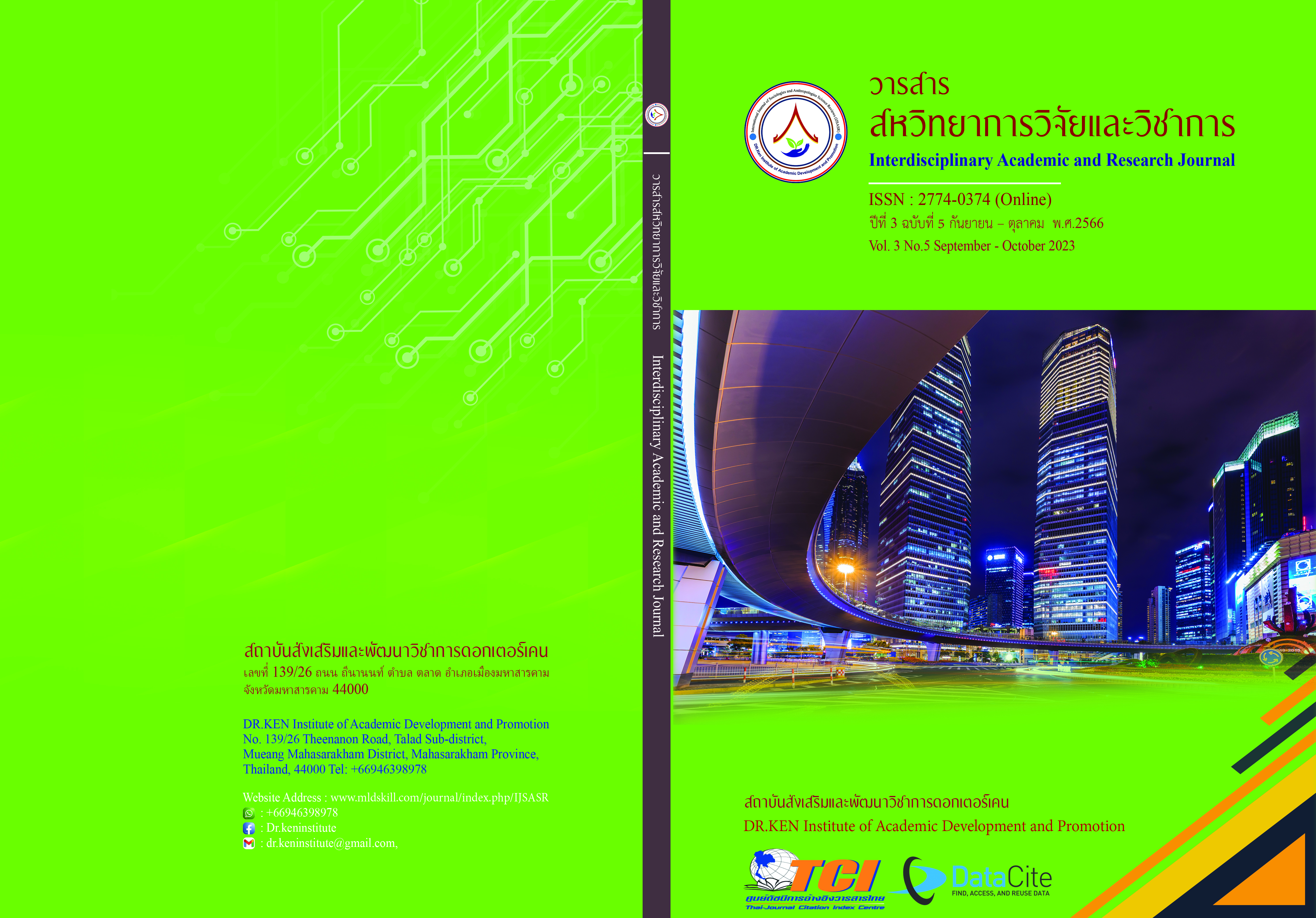Organizing Cooperative Learning Activities in Conjunction with the GeoGebra Program That Promotes Algebraic Thinking and Geometric Thinking Levels
DOI:
https://doi.org/10.14456/iarj.2023.272Keywords:
Organizing Cooperative Learning Activities; , GeoGebra Program; , Algebraic Thinking; , Geometric Thinking LevelAbstract
The objective of this research is to promote mathematics teaching and learning activities that facilitate effective learning of mathematics, enabling students to collaborate and help each other in problem-solving efficiently. Emphasizing mathematical and spatial thinking skills is of great importance for students. Therefore, the objectives of this research are as follows: 1) To develop collaborative learning activities using the GeoGebra program that meet the criteria of 75/75 effectiveness. 2) To study the impact of mathematical and spatial thinking skills. 3) To compare the levels of mathematical and spatial thinking with a score criterion of 70.
4) To examine the effectiveness index of collaborative learning activities using the GeoGebra program. 5) To investigate the satisfaction of students with collaborative learning activities using the GeoGebra program. The sample group used in the research consists of 39 students from the 3rd year of Vapi Pattana School. The research tools used include 1) Collaborative learning activities combined with the GeoGebra program. 2) Mathematical thinking assessment tests and geometric thinking level assessments. 3) Satisfaction surveys of students who learned through collaborative learning activities combined with the GeoGebra program. The statistical measures used in the research include frequency, percentage, mean, and standard deviation. The study found that: 1) Collaborative learning activities combined with the GeoGebra program had an effective learning activity organization with a score of 74.00/76.25. 2) Students had the highest level of mathematical thinking in terms of component awareness and basic geometric thinking, with a percentage of 94.87 and a level of 0, respectively. (3) The mathematical thinking and geometric thinking of the students were significantly higher than the criterion at a statistical significance level of .05, with percentages of 85.50 and 80.10, respectively, indicating an excellent level. 4) The effectiveness index of collaborative learning activities combined with the GeoGebra program was 73.65. 5) Students' satisfaction with the collaborative learning activities combined with the GeoGebra program was at the highest level, with an average score of 4.59.
References
กระทรวงศึกษาธิการ. (2561). หลักสูตรแกนกลางการศึกษาขั้นพื้นฐานพุทธศักราช 2551 (ฉบับปรับปรุง 2560). กรุงเทพฯ: ชุมนุมสหกรณ์การเกษตรแห่งประเทศไทย.
กาญจนา สายสุรินทร์. (2561). การศึกษามโนทัศน์ของรูปสามเหลี่ยมของนักเรียนชั้นมัธยมศึกษาตอนต้น. มหาสารคาม: มหาวิทยาลัยราชภัฏมหาสารคาม.
ขวัญฤดี วินไธสง ประภาพร หนองหารพิทักษ์ และ ปวีณา ขันธ์ศิลา (2562). การพัฒนาและเปรียบเทียบผลสัมฤทธิ์ทางการเรียนวิชาคณิตศาสตร์ เรื่อง เศษส่วน ของนักเรียนชั้นมัธยมศึกษาปีที่ 1 โดยใช้รูปแบบการเรียนรู้แบบร่วมมือเทคนิค TAI. การประชุมวิชาการระดับชาติและนานาชาติมหาวิทยาลัยกาฬสินธุ์ครั้งที่ 1 ประจำปี 2562 “นวัตกรรมด้านวิทยาศาสตร์และสังคมศาสตร์ เพื่อความยั่งยืน” (ครั้งที่ 1 ระหว่างวันที่ 15 - 16 กรกฎาคม 2562): 442-453.
จันทรา ตันติพงศานุรักษ์. (2543). การจัดการเรียนรู้แบบร่วมมือ (Cooperative Learning). วารสารวิชาการ. 3(12), 36-55.
ชลธิชา สาชิน. (2543). การพัฒนากิจกรรมการเรียนรู้คณิตศาสตร์โดยใช้กลุ่มร่วมมือแบบ TAI เพื่อส่งเสริมความสามารถในการคิดวิเคราะห์เรื่องพหุนาม ชั้นมัธยมศึกษาปีที่ 1. มหาสารคาม: มหาวิทยาลัยมหาสารคาม.
ทวีพงษ์ ดีพันธ์. (2563). ผลการใช้แบบฝึกทักษะ เรื่อง การคูณ โดยใช้รูปแบบการเรียนรู้แบบร่วมมือ เทคนิค TAI สำหรับนักเรียนชั้นประถมศึกษาปีที่ 2. ครุศาสตรมหาบัณฑิต สาขาวิชาหลักสูตรและการจัดการเรียนรู้.มหาวิทยาลัยราชภัฏบุรีรัมย์.
ปานทอง กุลนาถศิริ. (2546). ความสำคัญของคณิตศาสตร์. วารสารคณิตศาสตร์, 46(530-532), 11-15.
ฝ่ายวิชาการโรงเรียนวาปีปทุม. (2565). รายงานการดำเนินงานของฝ่ายวิชาการโรงเรียนวาปีปทุม. มหาสารคาม: โรงเรียนวาปีปทุม.
ยุพิน พิพิธกุล. (2545). การสอนคณิตศาสตร์. กรุงเทพฯ: คณะครุศาสตร์ จุฬาลงกรณ์มหาวิทยาลัย.
ศิริขวัญ พ่อค้า (2562). ผลของการจัดกิจกรรมการเรียนรู้ตามทฤษฎีคอนสตรัคติวิสต์ร่วมกับ โปรแกรม GeoGebra เรื่องเรขาคณิตวิเคราะห์ที่มีต่อความสามารถในการแก้ปัญหา. อุบลราชธานี: มหาวิทยาลัยอุบลราชธานี.
สถาบันทดสอบทางกาศึกษาแห่งชาติ(องค์การมหาชน). (2564). คู่มือการจัดสอบทางการศึกษาระดับชาติขั้นพื้นฐาน (O-NET) ชั้นประถมศึกษาปีที่ 6 และชั้นมัธยมศึกษาปีที่ 3. กรุงเทพฯ: สถาบันทดสอบทางการศึกษาแห่งชาติ(องค์การมหาชน).
สถาบันทดสอบทางกาศึกษาแห่งชาติ(องค์การมหาชน. (2558). คู่มือการจัดสอบทางการศึกษาระดับชาติขั้นพื้นฐาน (O-NET) ชั้นประถมศึกษาปีที่ 6 และชั้นมัธยมศึกษาปีที่ 3. กรุงเทพฯ: สถาบันทดสอบทางการศึกษาแห่งชาติ(องค์การมหาชน.
สถาบันส่งเสริมการสอนวิทยาศาสตร์และเทคโนโลยี. (2545). คู่มือการจัดการเรียนรู้กลุ่มสาระการเรียนรู้คณิตศาสตร์. กรุงเทพฯ: สถาบันส่งเสริมการสอนวิทยาศาสตร์และเทคโนโลยี.
สถาบันส่งเสริมการสอนวิทยาศาสตร์และเทคโนโลยี. (2548). เรขาคณิต. กรุงเทพฯ: โรงพิมพ์. สถาบันส่งเสริมการสอนวิทยาศาสตร์และเทคโนโลยี.
สุชานันท์ จงนอก. (2563). ผลการใช้กิจกรรมการเรียนวิชาคณิตศาสตร์ เรื่อง ร้อยละ ของนักเรียนชั้นประถมศึกษาปีที่ 5 ตามวิธีการจัดการเรียนรู้แบบร่วมมือเทคนิค TAI. วิทยานิพนธ์ศึกษาศาสตรมหาบัณฑิต (คณิตศาสตรศึกษา): มหาวิทยาลัยรามคำแหง.
อัศวรักษ์ ช่างอินทร์. (2559). การส่งเสริมความรู้สึกเชิงปริภูมิและการคิดทางเรขาคณิต เรื่อง ความสัมพันธ์ระหว่างรูปเรขาคณิตสองมิติและสามมิติของนักเรียนชั้นมัธยมศึกษาปีที่ 1 โดยใช้แนวการสอนของแวน ฮีลี่ ร่วมกับโปรแกรมจีโอมิเตอร์สเก็ตชแพด. เชียงใหม่: มหาวิทยาลัยเชียงใหม่.
Goodman. R.I., Fletcher, K.A., & Schneider, E.W. (1980). The Effectiveness Index as a Comparative Measure in Media Product Evaluation. Educational Technology. 20(9), 30-34.
Moonpo, P., Inprasitha, M., & Changsri, N. (2018). Algebraic Reasoning in Early Grade: Promoting through Lesson Study and Open Approach. Psychology, 9, 1558-1569.
National Council of Teachers of Mathematics [NCTM]. (2000). Principles and standards for school mathematics. Reston, VA: National Council of Teachers of Mathematics.
Ozçaklr, B., Ozdemir, D., & Klymaz, Y. (2020). Effects of dynamic geometry software on students’ geometric thinking regarding the probability of giftedness in mathematics. Alanya Alaaddin Keykubat University.
Palovicova & Zahorska. (2015). The Attitudes of Students to the Geometry and The About Square. Peer review under the responsibility of Academic World Education and Research Center, 1907 - 1912.
Pierce, R., & Stacey, K. (2007). Developing algebraic insight. Mathematics Teaching Incorporating Micromath, 203. 12-16.
ST. Nuaisyah karim. (2017). The Effectiveness of TAI (Team-Assisted Reading Individualization) to Improve Students' Comprehension at the Second Grade of Senior High School 1 South Polongbnagkeng. Universitas Islam Negeri Alauddin Makassar. Tarbiyah and Teaching Science.
Tinungki, G.M. (2015). The Role of Cooperative Learning Type Teams Assisted Individualization to Improve The Student's Mathematics Communication Ability in the Subject of Probability Theory. Hasanuddin University Makassar. Mathematics and Natural Sciences Faculty.
Van de Walle, J.A., K.S. Karp and J.M. Bay-Williams. (2011). Elementary and Middle School Mathematics: Teaching Developmentally. 7th edition. New York: Pearson Education.
Van Hiele, P.M. (1984). A Child's Thought and Geometry. In English Translation of Selected Writings of Dina Van Hiele-Geldof and Pierre M. Van Hiele, edited by D. Fuys, D. Goddess, and R.W. Tischler, 1959/1985. Brooklyn: Brooklyn College.
Downloads
Published
How to Cite
Issue
Section
License
Copyright (c) 2023 Bodeeson Anuchat, Ramnaree Nontapa

This work is licensed under a Creative Commons Attribution-NonCommercial-NoDerivatives 4.0 International License.
Copyright on any article in the Interdisciplinary Academic and Research Journal is retained by the author(s) under the under the Creative Commons Attribution-NonCommercial-NoDerivatives 4.0 International License. Permission to use text, content, images, etc. of publication. Any user to read, download, copy, distribute, print, search, or link to the full texts of articles, crawl them for indexing, pass them as data to software, or use them for any other lawful purpose. But do not use it for commercial use or with the intent to benefit any business.
















.png)


